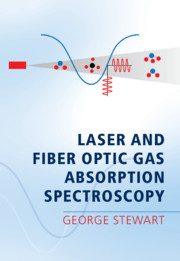Book contents
- Laser and Fiber Optic Gas Absorption Spectroscopy
- Laser and Fiber Optic Gas Absorption Spectroscopy
- Copyright page
- Dedication
- Contents
- Preface
- 1 Absorption Spectroscopy of Gases
- 2 DFB Lasers for Near-IR Spectroscopy
- 3 Wavelength Modulation Spectroscopy with DFB Lasers
- 4 Photoacoustic Spectroscopy with DFB Sources
- 5 Design and Application of DFB Laser Systems and Optical Fibre Networks for Near-IR Gas Spectroscopy
- 6 Principles of Fibre Amplifiers and Lasers for Near-IR Spectroscopy
- 7 Applications of Fibre Amplifiers and Lasers in Spectroscopy
- 8 Mid-IR Systems and the Future of Gas Absorption Spectroscopy
- Index
- References
3 - Wavelength Modulation Spectroscopy with DFB Lasers
Published online by Cambridge University Press: 07 April 2021
- Laser and Fiber Optic Gas Absorption Spectroscopy
- Laser and Fiber Optic Gas Absorption Spectroscopy
- Copyright page
- Dedication
- Contents
- Preface
- 1 Absorption Spectroscopy of Gases
- 2 DFB Lasers for Near-IR Spectroscopy
- 3 Wavelength Modulation Spectroscopy with DFB Lasers
- 4 Photoacoustic Spectroscopy with DFB Sources
- 5 Design and Application of DFB Laser Systems and Optical Fibre Networks for Near-IR Gas Spectroscopy
- 6 Principles of Fibre Amplifiers and Lasers for Near-IR Spectroscopy
- 7 Applications of Fibre Amplifiers and Lasers in Spectroscopy
- 8 Mid-IR Systems and the Future of Gas Absorption Spectroscopy
- Index
- References
Summary
Based on Fourier analysis, a theoretical description is given of the harmonics arising from current modulation of a DFB laser with its wavelength scanned through a gas absorption line. It is shown that each harmonic consists of a primary component from the wavelength modulation and two secondary components arising from the mixing of the intensity and wavelength modulations, with additional components if the laser light-current characteristic is non-linear. The importance of the lock-in detection phase is discussed and the need for calibration-free, consistent operation in the face of possible drift of laser parameters with time or with aging. Two methods are examined for extraction of gas parameters, one based on the effect of gas absorption on the laser intensity modulation, with correction factors applied at high modulation indices, and the other based on measurement of the second harmonic signal normalised through the first harmonic. It is shown that both methods can give similar sensitivities, but the harmonic ratio method is much superior in noise performance at the expense of increased complexity in signal processing and uncertainty if the laser parameters are prone to drift.
Keywords
- Type
- Chapter
- Information
- Laser and Fiber Optic Gas Absorption Spectroscopy , pp. 53 - 84Publisher: Cambridge University PressPrint publication year: 2021

